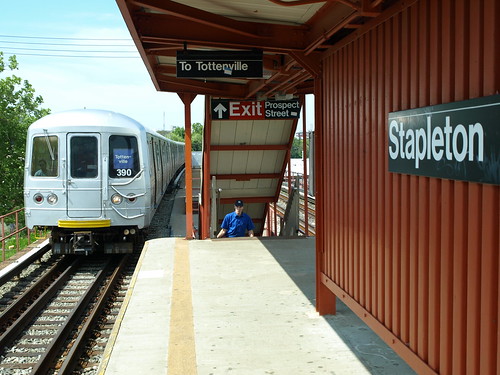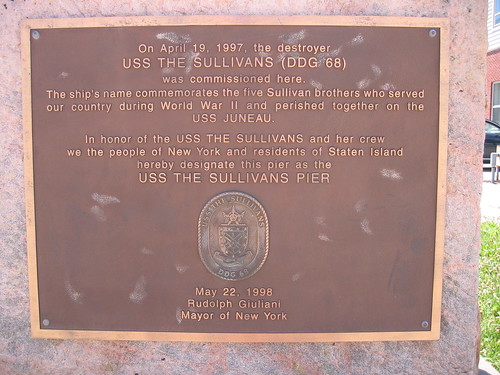
 Industry within Staten Island, and more specifically Stapleton, only truly took off in the 19th century. Previously, Staten Island was a rural borough that relied primarily on farming. Stapleton’s primary industries were the railroad (specifically construction of the railroad), the ferry, shipbuilding, and breweries. Although through the last century there has been an overall decline in the industries in Stapleton, there is evidence that certain industries are coming back to the community.
Industry within Staten Island, and more specifically Stapleton, only truly took off in the 19th century. Previously, Staten Island was a rural borough that relied primarily on farming. Stapleton’s primary industries were the railroad (specifically construction of the railroad), the ferry, shipbuilding, and breweries. Although through the last century there has been an overall decline in the industries in Stapleton, there is evidence that certain industries are coming back to the community.
At the start of the 19th century, Staten Island’s population had boomed, especially on the northern and eastern shores of the island. With the increased population came the need for better transportation within the island.

To resolve the issue of transportation within the island and to modernize with the rest of New York, in 1836, “a group of Staten Islanders…received charter to incorporate the Staten Island Railroad” into the rest of the city’s growing rail system [2]. However, the group never began construction of the railroad. In 1851, plans were draw up to finally construct a railroad between Tottenville and Stapleton. The railroad finally opened in stages from April 23 and June 2 1860.

Before the completion of the Staten Island Railroad (SIRR), residential and industrialgrowth had been booming. However almost immediately after its completion, the island’s growth had slowed down. This had nothing to do with the railroad. It actually was the result of American Civil War. During the war, Staten Island was used as a military encampment and a training ground and several of the island’s ferries were commandeered by the US Navy and converted into battleships [2, 4].
 The most known man in relation to the SIRR was Cornelius Vanderbilt. While he had nothing to do with the construction of the railroad, Vanderbilt owned the ferry terminals on Staten Island’s east coast (now Clifton), near where the railroad ended. In order keep earning money, Vanderbilt bought the railroad, and his family ran it as well as the ferry until 1871. With the inclusion of Vanderbilt’s ferry, a trip from Tottenville to Lower Manhattan took only ninety minutes [2].
The most known man in relation to the SIRR was Cornelius Vanderbilt. While he had nothing to do with the construction of the railroad, Vanderbilt owned the ferry terminals on Staten Island’s east coast (now Clifton), near where the railroad ended. In order keep earning money, Vanderbilt bought the railroad, and his family ran it as well as the ferry until 1871. With the inclusion of Vanderbilt’s ferry, a trip from Tottenville to Lower Manhattan took only ninety minutes [2].

Shipbuilding was a very large industry in Staten Island as whole but only played a small role in Stapleton’s industrial history. There were a total of “17 shipyards on Staten Island by 1880” and one of these piers, the Stapleton Pier was located in Stapleton [5,6]. This port primarily produced tugboats, propeller ships, yachts, and coal barges but by the mid-twentieth the pier had fallen into disuse.

However the Stapleton Pier is now used for other purposes than shipbuilding. In the late 1980’s the US Navy Strategic Homeporting Berthing Pier was constructed over the old pier. This pier was constructed in order to house the “USS Iowa Battleship Group.” In addition to the construction of this pier, the area around it is also being revitalized. This port was projected to create more than 4,000 jobs and nearly $400 million in additional revenue for the city.
 By the mid-1800’s, there were several breweries operating out of Staten Island. Schmidt’s Constanz Brewery (which was part of the Bachmann-Bechtel Company) was one of the breweries operated out of Stapleton. Like the other breweries on Staten Island, it was largely successful. However during Prohibition, Bachmann-Bechtel Company “failed almost immediately.” By the end of Prohibition only the Stapleton based brewery, Rubsam and Horrmann’s, “managed to survive” [3]. However Rubsam and Horrmann’s good fortune did not last much longer. Like many small businesses in the 1940’s and 1950’s, Rubsam and Horrmann’s struggled to compete with “large regional and national companies” [3]. The brewery shut down in 1953 and was eventually bought by Piel Brothers, Inc. Piel was then purchased by Drewry’s Limited U.S.A, Inc. Finally in 1976 the Rubsam and Horrmann complex was demolished.
By the mid-1800’s, there were several breweries operating out of Staten Island. Schmidt’s Constanz Brewery (which was part of the Bachmann-Bechtel Company) was one of the breweries operated out of Stapleton. Like the other breweries on Staten Island, it was largely successful. However during Prohibition, Bachmann-Bechtel Company “failed almost immediately.” By the end of Prohibition only the Stapleton based brewery, Rubsam and Horrmann’s, “managed to survive” [3]. However Rubsam and Horrmann’s good fortune did not last much longer. Like many small businesses in the 1940’s and 1950’s, Rubsam and Horrmann’s struggled to compete with “large regional and national companies” [3]. The brewery shut down in 1953 and was eventually bought by Piel Brothers, Inc. Piel was then purchased by Drewry’s Limited U.S.A, Inc. Finally in 1976 the Rubsam and Horrmann complex was demolished.
Citations:
[1] Ferreri, James G., and David Goldfarb. Stapleton. N.p.: Arcadia Publishing, 2012. Accessed April 15, 2012. http://books.google.com/books?hl=en&lr=&id=CFI_tZRUVY8C&oi=fnd&pg=PA6&dq=stapleton+ferry&ots=eyWB3xSRax&sig=s5NuAJuw58XzRWfxgSbxoMbVsi8#v=onepage&q&f=false.
[2] Minn, Michael. “History and Future of the North Shore Rail Line on Staten Island.” Accessed April 15, 2012. http://www.michaelminn.net/newyork/infrastructure/north_shore_railroad/north-shore-web.pdf.
[3] Sachs, Charles L. “Made on Staten Island.” Accessed April 15, 2012. http://eportfolios.macaulay.cuny.edu/sibilia12/files/2012/01/Made_On_Staten_Island_67-113.pdf.
[4] “Staten Island Timeline-1500’s to 1700.” Accessed April 15, 2012. http://www.statenislandhistory.com/historic-timeline.html.
[5] “Military-Mariners Harbor, Staten Island.” Accessed April 15, 2012. http://www.globalsecurity.org/military/facility/staten-island.htm.
[6] “Military-Naval Station New York Stapleton Pier / USS The Sullivans Pier Stapleton, Staten Island, NY.” Accessed April 15, 2012. http://www.globalsecurity.org/military/facility/staten_island.htm.


2 Responses to Stapleton